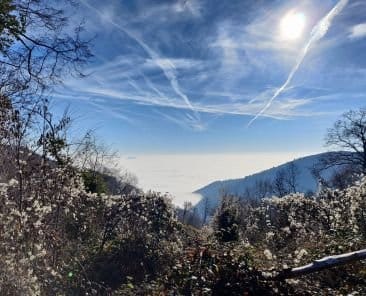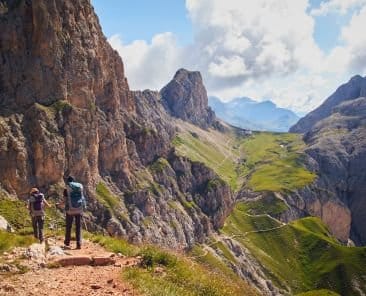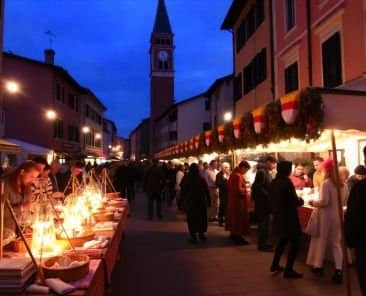Located in northeastern Italy, Veneto is one of the country’s 20 regions and is renowned for its rich cultural heritage, stunning landscapes, and beautiful cities (some of which are part of UNESCO heritage sites). It is a dynamic centre of trade, culture, and tourism because of its strategic location at the crossroads of Europe, at the very end of the famed Silk Road, which for hundreds of years was the main trade avenue between the Far East and Europe. For over a thousand years, the region was mostly in the sway of the Republic of Venice, until it was absorbed by the newly founded Kingdom of Italy in 1866. For this reason, it has human, historical, and economic characteristics all of its own.
From the sun-drenched Adriatic Sea coast to the snow-capped summits of the Dolomites mountain range, from the coast of Lake Garda to the river Po’s meandering turns, Veneto’s diverse geography is home to a multitude of breathtaking natural features, such as stunning lakes, lush plains, and undulating hills. The Adriatic Sea forms the region’s coastal sceneries, with its sandy beaches, quaint seaside villages, and historic ports, providing countless chances for leisure and enjoyment. The breathtaking natural scenery of the area makes for the ideal setting for outdoor activities like hiking, cycling, and wine tasting, enticing tourists to discover and take in the splendour of nature.
Veneto offers travellers a mesmerising fusion of history, culture, and natural beauty that is guaranteed to create a lasting impression thanks to its advantageous position, rich cultural legacy, and stunning scenery.
- Human Geography
When speaking of the human geography of Veneto, we must say it presents a vivid image of an area rich in diversity, life, and culture. As one of the most populated regions in Italy, home to more than 5 million people, Veneto offers the perfect combo of a peaceful rural atmosphere and vibrant urban centres.
The Veneto is, according to Eurostat, the fifth most visited region in the European Union – and that is mostly because of Venice. The famous capital of Veneto, Venice, is located by the eponymous lagoon and is well-known across the world for its elaborate canals, ageless beauty, and rich creative legacy. Venice serves as a cultural epicentre, attracting millions of visitors each year to explore its historic landmarks, vibrant neighbourhoods, and world-class museums.
Venice – the capital of the Veneto region
Apart from Venice, Veneto is home to several other significant cities, all of which support the cultural and economic life of the area. Verona, made famous by Shakespeare’s “Romeo and Juliet,” enthrals tourists with its historic amphitheatre, quaint atmosphere, and thriving arts and culture sector. Hosting one of the world’s oldest universities, Padua is home to a vibrant student body, interesting historical sites, and a strong artistic scene.
Verona- a city on the River Adige in Veneto, Italy
Other notable cities in Veneto are Rovigo, a quaint riverside town with a rich agricultural and cultural heritage; Vicenza, acclaimed for its elegant Palladian villas, UNESCO-listed historic centre, and thriving industrial sector, and Belluno, nestled among the majestic peaks of the Dolomites, offering breathtaking mountain vistas and outdoor recreational opportunities. Treviso is well-known for its picturesque canals, mediaeval architecture, and vibrant food scene. All in all, the region is home to well over one hundred towns with more than 10,000 inhabitants – many of them, like Montagnana, Cittadella, Bassano and Feltre, boasting centuries-old history in their own right.
Vicenza- a city in northeastern Italy
Belluno- a town and province in the Veneto region of northern Italy
Treviso- a city and municipality in the Veneto region of northern Italy
Veneto provides a multitude of cultural experiences, economic opportunities, and a high standard of living to both locals and tourists with its varied array of cities, towns, and communities. Its human geography represents an area that is filled with energy, creativity, and limitless potential that has succeeded in preserving and maintaining the beauty that has been living for centuries in this region.
Cultural Significance
Veneto’s cultural significance is deeply rooted in its rich history, artistic heritage, and vibrant traditions. The region, with Venice as its crown jewel, has long been a hub of cultural and artistic innovation, influencing both Italy and the broader world.
- History
Veneto has a long and rich history that includes different civilisations, empire times, and city-states, making its past a fundamental component of the region’s cultural relevance. It dates back to ancient times when it was inhabited by the Veneti, an ancient Indo-European group of people who established settlements along the Adriatic coast and inland plains. Cities like Patavium and Aquileia developed as hubs of trade, culture, and academia and Veneto eventually became a part of the Roman Empire. But as the Western Roman Empire collapsed in the fifth century, barbarian tribes invaded and caused chaos and instability to overrun the area.
During the Middle Ages, Veneto had a cultural and economic renaissance despite these obstacles, with strong city-states like Venice, Padua, and Verona developing as trade centres and patronage for the arts. An important turning point in the history of Veneto was the establishment of the Venetian Republic in the 8th century, which made Venice the dominating maritime force in the Mediterranean. The Venetian Republic flourished as the foundation of democracy, wealth, and cross-cultural interaction for more than a millennium, leaving a profound mark on Veneto’s identity and shared heritage.
[Third Italian War of Independence]
However, the fortunes of Veneto changed in the 19th century, as the region was annexed to the Kingdom of Italy in 1866 following the Third Italian War of Independence. Veneto’s cultural heritage endured the 19th-century political transformation, thanks to its preserved historic cities, architectural icons, and creative gems that constantly remind us of its enduring cultural significance and contributions to Italy and the rest of the world.
- Architecture
Veneto’s architecture is an interesting combination of Gothic and Renaissance styles, that reflect the region’s rich cultural heritage and artistic legacy. The majestic palaces and magnificent cathedrals, the charming piazzas, and graceful bridges, they’re all Veneto’s architectural marvels that today serve as a testament to centuries of inventive design, fine craftsmanship, and creative ability.
Famous for its elaborate mosaics and Byzantine domes, St. Mark’s Basilica in Venice is an excellent example of Venetian Gothic architecture. Adjacent to St. Mark’s Square, the Doge’s Palace is a remarkable model of Venetian Gothic architecture and another noteworthy monument. This magnificent palace, which housed the Venetian Republic’s administration, has elegant arcades, an elaborate marble façade, and a breathtaking interior filled with exquisite pieces created by well-known painters and sculptors.
Main façade of St Mark’s Basilica at Piazza San Marco
The Doge’s Palace facing the lagoon
Veneto saw a cultural renaissance during the Renaissance period, which was influenced by notable figures like Andrea Palladio. One of the most important examples of Venetian Renaissance architecture is the Palladian Basilica in Vicenza, which is well-known for its symmetrical design, elegant colonnades, and imposing porticoes.
Basilica Palladiana- a Renaissance building in the central Piazza dei Signori in Vicenza, north-eastern Italy
In addition to its Gothic and Renaissance landmarks, Veneto is also home to famous cultural locations like the Arena di Verona, a stunning Roman amphitheatre from the first century AD that still hosts top-notch opera performances and other events today. Juliet’s Balcony in Verona, which is famous for its portrayal of the legendary lovers in Shakespeare’s “Romeo and Juliet,” is another well-known site. Here, tourists may honour the couple and take in the quaint medieval architecture of Verona’s historic centre.
a Roman amphitheatre in Piazza Bra in Verona, Italy built in 30 AD
Juliet’s Balcony in Italy
Economic Overview
Veneto is a province rich in agriculture and supported by a booming industrial sector, excellent infrastructure, and a growing economy. Due to its strategic location and well-developed transportation infrastructure, Veneto is connected to major markets throughout Europe and beyond, facilitating global trade. It is served by several international airports that play a significant role in reducing both domestic and international travel, connecting the region to major cities and destinations worldwide, majorly Venice Marco Polo Airport (connecting Veneto to major cities across Europe, as well as destinations in Asia, North America, and the Middle East), Verona Villafranca Airport (connecting to cities across Europe, including hubs like Munich, Frankfurt, London, and Barcelona), and Treviso Airport (TSF).
Treviso Airport (TSF)
Venice Marco Polo Airport – the international airport of Venice
Veneto has a history of resilience and stability in terms of macroeconomic characteristics reflected in its strong economic indicators, with a Human Development Index (HDI) of 0.906. It has one of the strongest GDPs in Italy, and its diverse range of industries and sectors contributes to its thriving economy. The metal and machinery industry in Veneto, which includes transportation, electro-mechanics, metal processing, and fabrication machines, involves almost 25,000 companies and is the region’s most significant industrial sector. Apart from its industrial capabilities, Veneto is well-known for its thriving agricultural industry, which produces premium wines, olive oil, grains, and other agricultural goods.
[picture – Human Development Index (HDI)]
Furthermore, important industries like wine production, textiles, and tourism play a key role in Veneto’s economy. The textile industry in the area—represented by well-known labels like Diesel and Benetton—contributes to Veneto’s standing as a centre of the world of fashion. Similarly, the production of wine in Veneto contributes significantly to the region’s GDP and opportunities while also highlighting its gastronomic and cultural traditions. Last, but not from the importance, tourism is a major driver of the Veneto region’s economy, drawing millions of tourists to see its historic cities, landmarks, and natural attractions.
Natural Beauty
Witnessing the natural beauty of Veneto is simple, with its magnificent mountains and beautiful hills as representatives. About 29% of the region is mountains, like the Alpi Carniche, eastern Dolomites, and Venetian Prealps. Most of it, around 57%, is a big flat area that stretches to the sea, broken by some hills like Monti Berici, Colli Euganei, Colli Asolani, and Montello, that make up the rest, about 14%, of the region.
Located on the Northeastern side of Veneto, the Dolomite Mountains are recognised as a UNESCO World Heritage Site, known for their towering peaks, panoramic landscapes, and breathtaking views. This area is a paradise for outdoor enthusiasts and nature lovers, made out of towering limestone cliffs, beautifully flowing waterfalls, and dense alpine meadows.
Veneto is also home to Italy’s largest lake, Lake Garda, a breathtaking natural treasure positioned amidst hills and towns. The lake provides visitors with a peaceful getaway from daily life’s rush and is surrounded by lemon orchards, vineyards, and olive groves. In addition to taking gorgeous boat rides and relaxing on the shores, visitors can explore the peaceful lakeside communities.
The Venetian Lagoon, which stretches along the Venetian shore, is a special ecosystem rich in wildlife and breathtaking scenery. The lagoon, which is home to many smaller islands as well as the famous city of Venice, is a patchwork of marshes, wetlands, and canals that visitors can explore by boat, kayak, or bicycle, discovering hidden coves and remote islands.
In the southern part of Veneto, the Berici and Euganean Hills are a beautiful oasis of rolling hills, historic villages, and vineyards. Their historic villas, mediaeval castles, and thermal spas dotting the region, provide guests with a haven on earth, among the abundance of flora and fauna.
The Po Valley and southern plains encircle the huge agricultural heartland of Veneto, with its expansive, level terrain and rich soil. Picturesque farmhouses, vineyards, and orchards dot the boundless expanses of wheat, corn, and sunflowers that reach to the horizon. Numerous wetlands and natural reserves can be found in the Po Valley, which offers migrating birds and other species essential habitats. Visitors can experience the rural charm of the area by bicycle or automobile and discover hidden treasures like ancient towns, historic churches, and gorgeous rural panoramas.
Attractions and Activities
Veneto is a diverse destination with a variety of attractions including historic landmarks, Shakespearean romance, Padua’s Scrovegni Chapel, and Palladian architecture. Nature lovers can explore Lake Garda and Dolomites, while wine enthusiasts can enjoy Prosecco Hills and Venetian villas. Festivals like the Venice Biennale and Verona Opera Festival make Veneto a captivating destination. Here’s a brief description of attractions and activities in some of the major cities of Veneto.
- Venice
Venice is the capital of Veneto, built on a group of islands separated by open water and canals. It is often referred to as the “City of Canals” due to its network of waterways used as the primary mode of transportation. Visitors can enjoy the famous gondola rides, gliding the canals lined with historic buildings, and experience the timeless beauty of the city. Here, visitors also love to visit St. Mark’s Basilica, one of the most iconic landmarks of Italy, adorned with detailed mosaics, marble, and gigantic dorms, it’s a sign of Italy’s rich culture and heritage, pulling admirers from around the world.
The Grand Canal – a channel in Venice, forming one of the major water-traffic corridors in the city
Apart from its famed canals and basilica, Venice has a lot of attractions to explore, like Doge’s Palace, Rialto Market, the treasures of the Peggy Guggenheim Collection, and a lot more. For its unparalleled beauty and classic Roman architecture, Venice has been regarded as a UNESCO World Heritage Site. Its historic centre embodies landmarks like The Grand Canal and St. Mark’s Square, representing centuries of artistic and cultural accomplishments, preserving Venice’s legacy for generations to value.
- Verona
Regarded as one of Italy’s most cultural cities, Verona’s blend of history, culture, and natural beauty coupled with its persistent legacy in literature and arts. It has cemented its position as one of the most captivating cities in Italy. Dating back to the 1st century A.D., Verona’s Roman Amphitheatre, known as Arena de Verona, stands as an amazing reminder of the city’s legendary past.
Located in Verona’s historic centre lies a haven for literary enthusiasts and romantics, Juliet’s Balcony offers a glimpse into the fictional world of Shakespeare’s “Romeo and Juliet”, attracting visitors from all over the world with its romantic ambience and folklore. Verona’s cultural calendar comes alive during summer as magnificent Opera performances take place in Arena di Verona.
From classic operas to modern plays, Verona’s open-air festival provides a unique opportunity for visitors to experience the magic of opera amidst the walls of the amphitheatre. In addition to its Roman heritage and Shakespearean connection, Verona offers many attractions waiting to be discovered, from vibrant and colourful markets offering high-end clothing, jewellery and fragrances to historic landmarks and an array of local cuisines. Whether wandering its ancient streets, attending a performance in the Arena, or simply soaking in the romantic atmosphere, visitors to Verona are sure to be enchanted by its eternal charm.
- Padua
Padua, known as Padova in Italian, holds a special place in Italy’s historic and cultural landscape. It is the home to the most prestigious and oldest university in the world, the University of Padua (Università degli Studi di Padova), founded in 1222. This prestigious institution played a very important role in shaping the ethnic and intellectual landscape, drawing students, researchers and academics from all over the world.
Within Padua nestles in the masterpiece of medieval art and architecture, The Scrovegni Chapel, adorned with exquisite frescoes by the renowned Italian artist Giotto depicting scenes from the life of Christ and the Virgin Mary.
Padua helms in one of the largest city squares in Europe, Prato della Valle, a wide and magnificent public space renowned for its monumental architecture and breathtaking scenery. Surrounded by gigantic statues, picturesque palaces and lush gardens the square serves as a hub of activity hosting markets, festivals, and cultural events throughout the year. Overall, travellers wishing to explore Italy’s diverse cultural landscape will find Padua to be an enthralling destination due to its unique combination of academic distinction, artistic legacy, and historical relevance.
- Outdoor Activities
In the middle of its magnificent natural setting, Veneto offers a diverse range of activities catering for the needs of all kinds of visitors from nature lovers, to sports enthusiasts and explorers. It offers a world-famous ski resort Cortina d’Ampezzo for ll the ski enthusiasts right in the heart of the Dolomite Mountains, known for its pristine slopes, scenic views, and opulent services. All skill levels of snowboarders and skiers can enjoy a range of runs that cater to different abilities, from beginner-friendly gentle slopes to challenging terrains for experts.
Veneto encapsulates a nirvana for hikers and outdoor enthusiasts, The Dolomites, a beautiful UNESCO World Heritage site that is home to a network of breathtaking paths that run between towering peaks, lush valleys, and stunning alpine meadows. There are options for every interest and skill level from easy strolls to challenging treks.
Dolomitic Alps- a mountain range in northeastern Italy
Veneto also helms in the largest lake in Italy, Lake Garda, boasting a magnificent shoreline and crystal clear waters. Visitors enjoy a vast range of outdoor activities with friends and family there. In addition to relaxing on the beach, taking scenic boat tours, and exploring quaint lakeside towns, watersports enthusiasts can enjoy sailing, windsurfing, kayaking, and kiteboarding. Numerous hiking and bike routes that give expansive views of the lake and neighbouring mountains are also located around the lake.
VI. Gastronomy and Wine
The gastronomy of Veneto is a lovely reflection of the region’s abundant natural resources and rich culinary legacy. The area’s cuisine is known for its well-balanced flavours, which both the sea and the land influence. Many traditional recipes start with staples like polenta and risotto and are served with a variety of fresh seafood specialities like Sarde in Saor, which is a reflection of Veneto’s coastal origins. Another well-liked delicacy in the area is Baccalà Mantecato, a spread created from whipped salted fish that has been flavoured with garlic and olive oil. Whether you’re delighting in the complex flavours of Baccalà Mantecato or relishing a comfortable bowl of Risotto, dining in Veneto is an immersive experience that celebrates the region’s rich culinary traditions and gastronomic legacy.
In addition to its delectable cuisine, Veneto is renowned for its outstanding wines, which are among the best in Italy. The area’s varied terroir, from the sun-drenched slopes of Conegliano and Valdobbiadene to the rolling hills of Valpolicella, allows for the growth of many grape varietals. Famous classics like Prosecco, a sparkling wine renowned for its crisp acidity and energetic effervescence, and Amarone, a full-bodied red wine cherished for its rich notes of dried fruit, spice, and earth, are among Veneto’s wine offerings. The wine areas of Valpolicella, Conegliano, and Valdobbiadene are well-known for their charming vineyards, historic wineries, and passionate winemakers. These locations provide visitors with the chance to experience the best wines of the region in breathtakingly beautiful natural settings.
VII. Conclusion
Veneto, with its diverse variety of history, culture, natural beauty, and delectable cuisines, presents a charming destination perfect for a wide range of travellers from history buffs to art enthusiasts, nature lovers to food specialists with a wide array of culinary delights, and anyone who wants to experience a taste of quality life. Veneto offers an array of activities to enjoy in all four seasons, including skiing, hiking and cycling itineraries, city sightseeing, concerts etc. Explore its enchanting landscapes, and vibrant cities, and experience the energetic nightlife to feel the essence of this captivating region.
Was this helpful?
Good job! Please give your positive feedback
How could we improve this post? Please Help us.


















